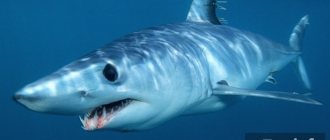Most people perceive sharks as real monsters that are capable of attacking a person at the first opportunity. By and large, this image is formed by feature films about monster sharks, however, they cannot be called cute creatures, since attacks by these predators on people still happen.
flickr/George Probst
Sharks are dangerous, and this must always be remembered, and they are dangerous not only because they have sharp teeth, powerful jaws and are incredibly strong, but also because their behavior can be unpredictable. In addition, some of them are incredibly aggressive. Among sharks, there are a dozen representatives that are considered the most dangerous for humans, a meeting with which can end quite sadly.
Bull shark, bull shark
Bull shark, or blunt-nosed shark (lat. Carcharhinus leucas) - this marine predator deserves the title of one of the most dangerous, as it has repeatedly attacked humans, and most often it ended in death for the latter. Numerous studies have shown that this shark is one of the most aggressive sharks, especially during hunting.
flickr/eloyhouse
In addition to the fact that the bull shark lives in salt water, it quite often enters rivers, rising upstream for many kilometers. They have also been spotted in Lakes Michigan and Nicaragua. The body length of the bull shark reaches up to 3.29-3.5 m, weight - about 320-450 kg.
The most predatory, aggressive, bloodthirsty. dangerous shark in the world: name, description - what does it look like?
- is considered the most aggressive and bloodthirsty . Its main habitat is the Pacific coast. The predator is often found near the beaches.
- The shark loves to swim in warm waters, and therefore during the onset of cold weather it urgently migrates. Thanks to the warm current, she swims to where she is more comfortable.
- The body of the fish has many stripes on the sides. The length of the young predator is 2 m. The smaller representatives of this species have gray skin, they can camouflage themselves in the water, literally blending in with it.
Dangerous
- The belly of an adult predator is white , with yellow spots on it . A tiger shark can have a body length of a maximum of 4 m. Its weight is up to 400 kg. However, there have been many more representatives in history.
- The shark is slow and quite calm. She slowly swims up to her prey and does not show the slightest bit of aggression. When a fish wants to eat, it does not leave the victim a chance to escape. The predator attacks quickly, bites the victim's body, and then feasts on it.
- The tiger shark does not pick at its food. If there is a lack of fresh food, she can even eat carrion. Scientists have been able to establish that large tiger sharks eat smaller ones.
- If a predator is in troubled waters, it opens its mouth and begins to swallow all the fish that come across its path. That is why people find unusual objects inside the belly of a shark, even those that are completely inedible.
Great white shark
Great white shark, or carcharodon (lat. Carcharodon carcharias) - This marine predator has already accounted for more than fifty human lives. Lives in all oceans except the Arctic. The white shark can reach 6 meters in length and weigh more than 2 tons.
flickr/remainingoceansart
This species is on the verge of complete extinction, as there are only about 3.5 thousand individuals left. According to the International Shark Attack File (from 1990 to 2011), 139 (!) cases of great white shark attacks on people were recorded (29 of them were fatal).
Reproduction
Blacktip reef sharks have a very long reproductive period, which also affects their numbers. Pregnancy lasts from 7 to 11 months, depending on the animal’s habitat.
They practice viviparity. After fertilization, an egg is formed inside the female, which hatches there. Embryos grow quickly. By the time of birth they grow up to 50 centimeters. One female brings 2-5 cubs.
Juveniles live in mangroves or on very shallow coasts with sandy bottoms. In the first two years they continue to grow rapidly, adding 20 centimeters each, then growth slows down. Animals reach sexual maturity when they grow to about one meter.
Tiger shark
The tiger shark, or leopard shark (lat. Galeocerdo cuvier) is also considered a man-eating shark, in addition, this shark is not very picky about food - it can swallow everything that comes in its way.
flickr/sterlingz
It lives in the waters of the World Ocean (both in open waters and off the coast). The length of a tiger shark can reach 3.3 meters (maximum length - 7.5 m), weight - about 635 kg (maximum weight - 807.4 kg).
Bloody messenger of tragedy
The long-winged shark, which is in fourth place in the top ten most dangerous sharks, inspires fear with its appearance alone.
Large size, disproportionately long fins, triangular and dagger-sharp teeth, and, to top it all, not at all friendly character - a meeting with this persistent and unshakable killer, stubbornly pursuing his goal, can have sad and even tragic consequences.
Fortunately, whitetip sharks are rarely seen near the coast, but they are responsible for a huge number of victims in the open ocean, including in cases of plane crashes or shipwrecks with numerous victims in the water.
Representatives of this species live in almost all tropical and subtropical waters of the globe.
Photo: Longtip shark
Longtip shark
Longwing shark (lat. Carcharhinus longimanus) - this shark lives in clean and deep water, its preferred temperature is from 20°C to 28°C.
flickr/matt9122
It can reach a length of up to 3.5-4 meters, weight - about 20-60 kg. Due to its love for warm water, it is quite often found with humans. It has been repeatedly seen attacking people swimming in tropical waters or shipwrecked people.
Blue shark - fatal beauty
In penultimate, ninth place is another shark with an unusual color, this time blue. The blue or cyan shark has an indigo back, blue sides, and a perfect white belly.
This colorful predator, with a spindle-shaped shape and long pectoral fins, can be found in tropical, subtropical and temperate latitudes of the Pacific Ocean.
Nature has deprived these fish of the ability to distinguish colors, rewarding them with excellent orientation and sensitive recognition of subtle contrasts.
The length of the blue shark is on average 3-4 meters, and opinions about its aggressiveness are often contradictory, but most researchers agree that these fish are extremely warlike and are ready to attack the enemy at any moment.
Photo: Blue Shark
Sharpnose mako shark
The sharpnose mako shark, or blacknose shark, or gray-blue herring shark, or mackerel shark (lat. Isurus oxyrinchus) is a large shark from the family of herring sharks (lat. Lamnidae).
flickr/Antonio Amaral
There were about 40 attacks on humans by these sharks, but mostly they were not fatal. They gained their fame thanks to their ability to reach speeds of up to 50 km/h and jumping out of the water to a height of several tens of meters. The maximum length of this shark is 4.45 m.
Nutrition
Like most other sharks, blacktip reef sharks are predators. Their main prey is bony fish of the ray-finned class. Both medium-sized animals (30-50 cm) and rather large representatives, the size of which can exceed one meter, become victims of sharks.
The predator's diet includes mullet, grouper, wrasses, surgeonfish and shadfish. However, they are not limited to fish alone; they also eat small mammals, squid, octopuses, cuttlefish, other sharks and rays. In coastal waters they can also hunt sea snakes and rats.
Their eyes are poorly adapted to distinguish small details and colors. They find prey by smell. They are also attracted to the sound of water hitting and movement. They can distinguish not too large objects from a distance of 1-3 meters, but at the same time they poorly identify its shape. This may be why they sometimes find anything, even stones, in the stomachs of sharks.
When there is an abundance of food, in critical situations, or when there is a strong smell of blood, they can fall into a “food frenzy.” At such moments, sharks quickly and chaotically begin to rush at everything that moves. Divers sometimes suffer from this.
Reef shark
The reef shark (lat. Triaenodon obesus) is a predatory fish belonging to the family of gray sharks (lat. Carcharhinidae).
flickr/Philippe Guillaume
The eyes of this predator are protected by a special eyelid that closes when attacked. Reef sharks have attacked people less than ten times, and fortunately the latter always survived. This is a fairly small shark, about 2.13 m long.
Deadly Guardian of the Coral Reefs
The sixth place on the list of the most dangerous sharks is occupied by the gray reef shark, armed with large triangular teeth with jagged edges and having a length of about 2 meters.
As the name suggests, the preferred habitats of this fish are rocks and coral reefs located in the Red Sea, as well as the Pacific and Indian Oceans.
The high speed and maneuverability of the gray reef shark is ensured by the torpedo-shaped body, which has a gray color with a characteristic black edging on the tail.
Cruel and merciless, she is capable of becoming furious even from minor vibrations of water and without hesitation attacking the source of irritation. Having nervously circled around the victim, it arches its back, opens its mouth and makes a swift attack - this is what an attack by a gray reef shark looks like.
Photo: Gray reef shark
Watch the video - Why are killer sharks from the TOP 10 dangerous:
sand shark
The sand shark (lat. Carcharias taurus) is a predatory fish of medium length (from 250 to 320 cm).
flickr/Alfonso Exposito
Embryos (during development inside the uterus) are characterized by homophagy (eating raw meat). Tiny sharks feed not only on unfertilized eggs, but also on fully formed brothers and sisters, acting on the principle “only one will survive.” In addition, they quite often attacked people (from 1990 to 2011, 30 cases of attacks on humans were recorded).
Hammerhead sharks
Hammerhead sharks (lat. Sphyrnidae) are predatory fish from the order of carcharine sharks.
flickr/NereaG
A distinctive feature is the unusual shape of the head, which resembles a hammer. Adults can reach 6 m (there are specimens 7-8 m in length). It is considered a rather ferocious shark, but the hammerhead does not attack people as often as the other aforementioned representatives. Rumors about the incredible aggressiveness of this shark are most likely due to its ominous appearance.
Lemon or yellow shark
Lemon or yellow sharks (lat. Negaprion brevirostris) - belongs to the species of gray sharks.
flickr/matt9122
The body length of the lemon shark is about 340 cm. They become especially aggressive during the breeding season, but even in normal times they are easy to anger. There were 20 cases of attacks on people, but all of them survived. Lemon sharks are potentially dangerous to humans. Today, this shark is on the verge of complete extinction.
Hammerfish
This individual can be called the most dangerous shark in the world for humans due to its unpredictability and strength. She is able to swim into shallow water, where she hunts her victims. It is here that the predator produces its offspring, becoming most aggressive at this time.
A distinctive feature of the fish is its head, which looks very much like a hammer. But this does not prevent the predator from being agile and swift, attacking its prey at the speed of a torpedo. During the production of offspring, you should not be near her, otherwise you can become prey and food for the fry.
Among the native Hawaiians, this predator is a totem animal and deity. Therefore, hunting them is prohibited near the Hawaiian Islands, even if people are injured.
What makes this shark different is its head.











